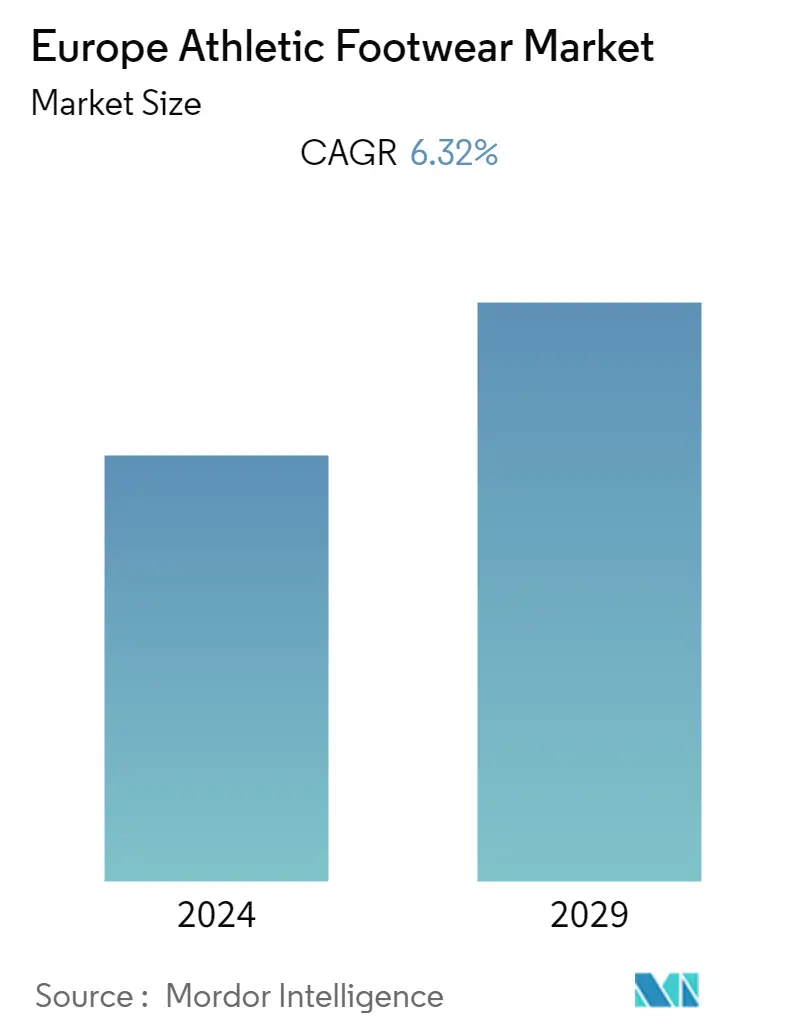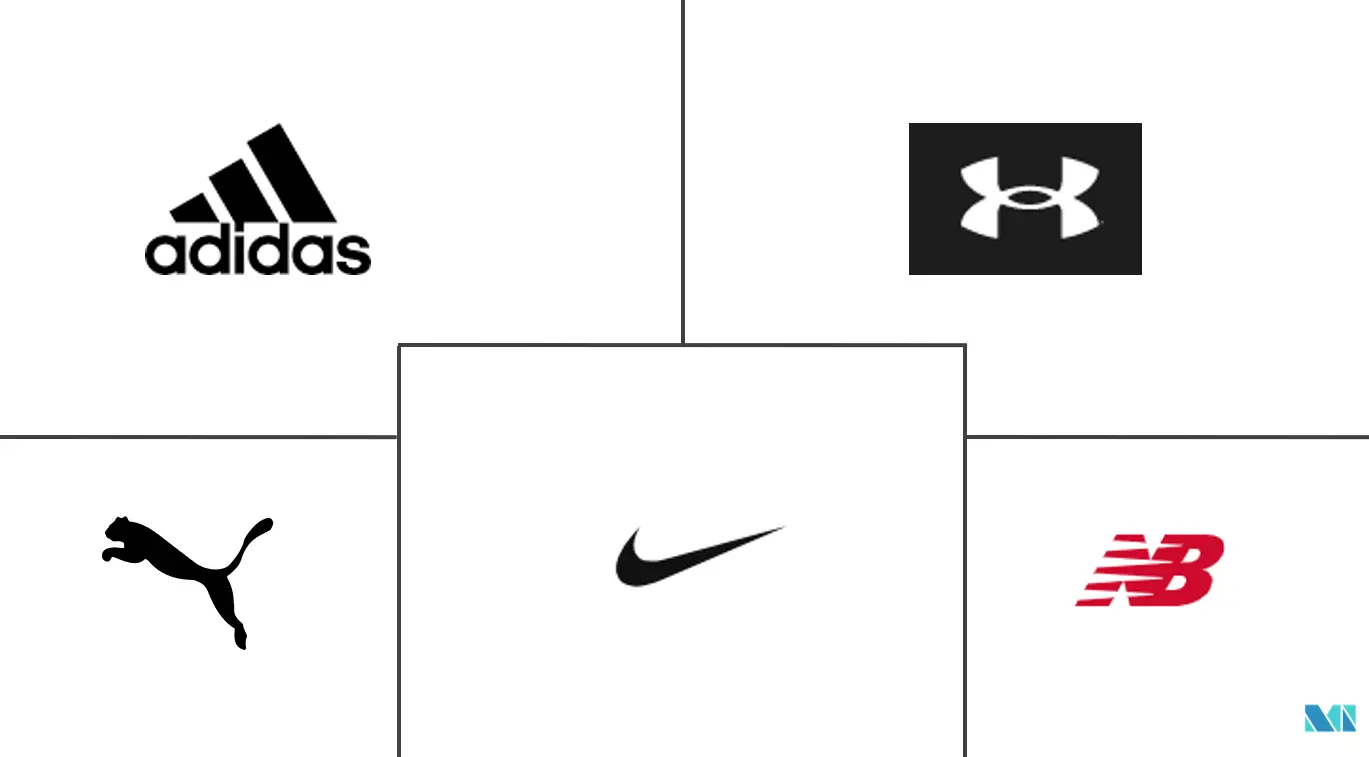Market Size of Europe Athletic Footwear Industry

| Study Period | 2019 - 2029 |
| Base Year For Estimation | 2023 |
| Forecast Data Period | 2024 - 2029 |
| Historical Data Period | 2019 - 2022 |
| CAGR | 6.32 % |
| Market Concentration | Low |
Major Players
*Disclaimer: Major Players sorted in no particular order |
Europe Athletic Footwear Market Analysis
The Europe Athletic Footwear Market is projected to witness a CAGR of 6.32% during the forecast period (2022-2027).
The market growth in the region can be attributed to several factors such as the growing number of sports clubs in Europe, more women participating in daily sports activities, and a shift towards fitness and gym workouts. The rise in the health and wellness trend is one of the primary aspects driving the sales of athleisure footwear in European countries as fitness-inspired lifestyles promote active participation in various sports and exercises such as running, jogging, and cycling. Further, consumers have easy access to a variety of footwear types marketed by private label and global brands across online and offline retail channels. In the medium term, online channels are anticipated to register a significant surge in athletic footwear sales as millennials are highly inclined toward e-commerce platforms for purchasing lifestyle and fashion products.
Moreover, key manufacturers are emphasizing the development of sustainable products to capture the interest of eco-conscious consumers. For example, in June 2021, Nike unveiled "Happy Pineapple," a series of plant-based athleisure sneaker lines made from plant-based leather. The brand has partnered with the business Piatex, which creates pineapple-based leather from resilient fibers of pineapple leaves.
Europe Athletic Footwear Industry Segmentation
Athletic footwear is a generic name for shoes that are used in sporting and fitness activities. The Europe athletic footwear market is segmented by product type, end-user, distribution channel, and geography. By product type, the market is segmented into running shoes, sports shoes, trekking/hiking shoes, and other product types. By end user, the market is segmented into men, women, and children. By distribution channel, the market is segmented into sports and athletic goods stores, supermarkets/hypermarkets, online retail stores, and other distribution channels. By Geography, the market is segmented into Germany, the United Kingdom, France, Italy, Spain, and the Rest of Europe. For each segment, the market sizing and forecasts have been done based on value (in USD million).
| By Product Type | |
| Running Shoes | |
| Sports Shoes | |
| Trekking/Hiking Shoes | |
| Other Product Types |
| By End User | |
| Men | |
| Women | |
| Children |
| By Distibution Channel | |
| Sports and Athletic Goods Stores | |
| Supermarkets/Hypermarkets | |
| Online Retail Stores | |
| Other Distribution Channels |
| By Geography | |
| Germany | |
| United Kingdom | |
| France | |
| Italy | |
| Spain | |
| Rest of Europe |
Europe Athletic Footwear Market Size Summary
The Europe athletic footwear market is experiencing significant growth, driven by a surge in health and wellness awareness, increased participation in sports, and a shift towards fitness-oriented lifestyles. The proliferation of sports clubs and the rising number of women engaging in daily sports activities are contributing to this trend. The market is further bolstered by the accessibility of a wide range of footwear options from both private label and global brands through online and offline retail channels. The growing preference for e-commerce, particularly among millennials, is expected to enhance online sales of athletic footwear. Additionally, manufacturers are focusing on sustainability to attract eco-conscious consumers, with innovations such as plant-based materials gaining traction.
The demand for athletic footwear is also influenced by health concerns like obesity and cardiovascular diseases, prompting more individuals to adopt active lifestyles that include activities such as running, yoga, and gym workouts. The expanding older population in the European Union, who favor jogging and brisk walking, is anticipated to drive growth in the running shoe segment. The United Kingdom, in particular, shows high consumer spending on personal well-being and a strong participation in outdoor sports, supported by a robust infrastructure of fitness centers and sports clubs. The competitive landscape features major brands like Nike, Adidas, and Puma, which are leveraging product innovation and sustainable practices to maintain their market position. These companies are also expanding their distribution networks and investing in research and development to enhance their offerings.
Europe Athletic Footwear Market Size - Table of Contents
-
1. MARKET DYNAMICS
-
1.1 Market Drivers
-
1.2 Market Restraints
-
1.3 Porter's Five Force Analysis
-
1.3.1 Threat of New Entrants
-
1.3.2 Bargaining Power of Buyers/Consumers
-
1.3.3 Bargaining Power of Suppliers
-
1.3.4 Threat of Substitute Products
-
1.3.5 Intensity of Competitive Rivalry
-
-
-
2. MARKET SEGMENTATION
-
2.1 By Product Type
-
2.1.1 Running Shoes
-
2.1.2 Sports Shoes
-
2.1.3 Trekking/Hiking Shoes
-
2.1.4 Other Product Types
-
-
2.2 By End User
-
2.2.1 Men
-
2.2.2 Women
-
2.2.3 Children
-
-
2.3 By Distibution Channel
-
2.3.1 Sports and Athletic Goods Stores
-
2.3.2 Supermarkets/Hypermarkets
-
2.3.3 Online Retail Stores
-
2.3.4 Other Distribution Channels
-
-
2.4 By Geography
-
2.4.1 Germany
-
2.4.2 United Kingdom
-
2.4.3 France
-
2.4.4 Italy
-
2.4.5 Spain
-
2.4.6 Rest of Europe
-
-
Europe Athletic Footwear Market Size FAQs
What is the current Europe Athletic Footwear Market size?
The Europe Athletic Footwear Market is projected to register a CAGR of 6.32% during the forecast period (2024-2029)
Who are the key players in Europe Athletic Footwear Market?
Adidas AG, Under Armour Inc., Puma SE, New Balance Athletics Inc. and Nike Inc. are the major companies operating in the Europe Athletic Footwear Market.

